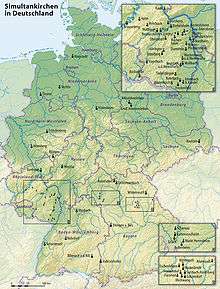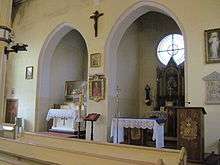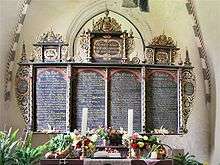Simultaneum
A shared church (German: Simultankirche), simultaneum mixtum, a term first coined in 16th-century Germany, is a church in which public worship is conducted by adherents of two or more religious groups. Such churches became common in the German-speaking lands of Europe in the wake of the Protestant Reformation.[1] The different Christian denominations (such as Roman Catholic, Lutheran, Reformed, or United, etc.), share the same church building, although they worship at different times and with different clergy. It is thus a form of religious toleration.[1]
Simultaneum as a policy was particularly attractive to rulers who ruled over populations which contained considerable numbers of both Catholics and Protestants. It was often the opposite of cuius regio, eius religio and used in situations where a ruler was of a different religion than the majority of the people, and not strong enough to impose his religion on the population.[1]
During the Nine Years' War (1688–1697), Louis XIV of France occupied the Electorate of the Palatinate, a Protestant region situated mainly in the western part of what is today Germany, where he introduced the simultaneum. At the end of the war the region returned to Protestant control, but a last-minute addition to the Treaty of Ryswick provided for a continuation of the simultaneum. Although intended to apply only to the Palatinate, the simultaneum was subsequently also applied in portions of Protestant Alsace (a region ruled by France, but where the Edict of Fontainebleau was not enforced).
Examples


Belgium
- Olne, province of Liège; a simultaneum was introduced in 1649
- Rheinberg-Ossenberg, Castle Chapel, a Catholic-United simultaneum until the present day
France
- Béarn - there used to be a simultaneum there between 1561–1569
- Old Saint Peter's Church, Strasbourg, Alsace; now divided into separate Protestant and Catholic churches
- Wissembourg, Alsace: there was a so-called trimultaneum, with a Catholic, Lutheran, and Reformed congregation sharing one church
Germany
- Altenberg im Bergischen Land, Altenberger Dom, since 1857 Catholic-United simultaneum
- Althaldensleben, Double Church, Catholic-United simultaneum until the present day
- Bautzen, St. Peter's Cathedral, oldest Catholic-Lutheran simultaneum since 1524
- Bechtolsheim, Ss. Mary and Christopher, Catholic-United simultaneum until the present day
- Berlin, French Church of Friedrichstadt, Calvinist-United simultaneum since 1981
- St. Martin's Church, Biberach, Catholic-Lutheran simultaneum until the present day
- Biebelsheim, St. Martin's Church, Catholic-United simultaneum until the present day
- Boos upon Nahe, Simultaneum,[2][3] Catholic-United simultaneum until the present day
- Brauneberg, St. Remigius Church, Catholic-United simultaneum until the present day
- Braunfels, Castle Church, since 2005 a Catholic-United simultaneum
- Wildenreuth, St. James' Church, Catholic-Lutheran simultaneum until the present day
- Fröndenberg, Collegiate Church, Catholic-United simultaneum until the present day
- Gau-Odernheim, St. Rufus Church, Catholic-United simultaneum until the present day
- Goldenstedt, in Vechta, Lower Saxony was a simultaneum between 1650 and 1850.
- Groß Ammensleben, former Cloister Church, from 1614 until 1817 a Catholic-Lutheran simultaneum, since then a Catholic-United simultaneum
- Hahn im Hunsrück, Catholic-United simultaneum until the present day
- Hildesheim, St. Michael's Church, since 1542 a Catholic-Lutheran simultaneum
- Frankenhof, St. Margareth Church, Catholic-Lutheran simultaneum until the present day
- Götzendorf in Bavaria, St. Magdalena Church, Catholic-Lutheran simultaneum until the present day
- Illschwang, St. Vitus Church, Catholic-Lutheran simultaneum until the present day
- Kulmbach, the castle chapel on the Plassenburg, Catholic-Lutheran simultaneum until the present day
- Mosbach, St. Juliana Collegiate Church, Catholic-United simultaneum until the present day
- Neuried-Schutterzell, St. Michael's Church, a Catholic-United since 1804
- Neustadt an der Weinstraße, Collegiate Church, Catholic-United simultaneum until the present day
- Otterberg, Otterberg Abbey, Catholic-United simultaneum until the present day
- Ringstedt, St. Fabian Church, since 1706 a Reformed-Lutheran simultaneum
- Rohrdorf in the Black Forest, John's Church, a Catholic-United simultaneum until the present day
- Saarbrücken, Church of Peace (German: Friedenskirche), an Old Catholic-Russian Orthodox simultaneum until the present day
- Siebeldingen, St. Quintinus Church, a Catholic-United simultaneum until the present day
- Thuine, St. George's Church, Catholic-Reformed simultaneum until the present day
- Vechta, Cloister Church (German: Klosterkirche), since 1818 a Catholic-Lutheran simultaneum
- Wachenheim an der Weinstraße, St. George's Church, Catholic-United simultaneum until the present day
- Wetzlar, former collegiate church, colloquially Wetzlar Cathedral, since 1544–1817 a Catholic-Lutheran, from then on a Catholic-United simultaneum
- Wilnsdorf-Rödgen, St. John the Baptist Church, Catholic-United simultaneum until the present day
- Worms-Pfeddersheim, simultaneum, Catholic-United simultaneum until the present day
- Worms-Rheindürkheim, St. Peter Church, Catholic-United simultaneum until the present day
Poland
- Gniezno, St. Michał Kozal Church, Roman Catholic and Evangelical (of the Augsburg confession) simultaneum (the church with two presbiteries)
United Kingdom
- Arundel, St. Nicholas Church and Fitzalan Chapel, an Anglican parish church with a Roman Catholic chapel, the burial place of the Dukes of Norfolk.
United States
- Virginia Beach, Church of the Holy Apostles, Roman Catholic and Anglican simultaneum[4]
Holy Land church-sharing
The main traditional pilgrim churches of Jerusalem and Bethlehem are shared between several denominations. The regulatory work is known as the "Status quo", a type of church-sharing which is in no way related to the West European Protestant-Catholic sharing system described here (the "simultaneum").
- Church of the Holy Sepulchre, Jerusalem - Greek Orthodox-Eastern Orthodox-Oriental Orthodox-Catholic simultaneum until the present day
- Church of the Nativity in Bethlehem
References
- HighBeam Research, dictionary definition: simultaneum
- Wiki-Protestants.org, Simultaneum (French language)
- Musée virtuel du Protestantisme, "Le Simultaneum" (French language): "Le simultaneum résulte de l'histoire alsacienne. Il s'agit d'un édifice cultuel utilisé simultanément par les deux confessions catholique et protestante."
- [The] Rhein and Laeng of Herrliesheim: Brief History of Alsace-Lorraine
- Bernhard Brockmann, Simultaneum in Goldenstedt
Notes
- Religious Conflict and the Practice of Toleration in Early Modern Europe, Harvard University Press, 2007, Chapter 8, pp. 198. ff..
- Simultaneum in Boos (Nahe)
- Boos (Nahe), photos of the simultaneum
- "Two Altars, One Mass: Catholics and Episcopalians worship together in a unique church". TIME. 117: 20. 1981.
